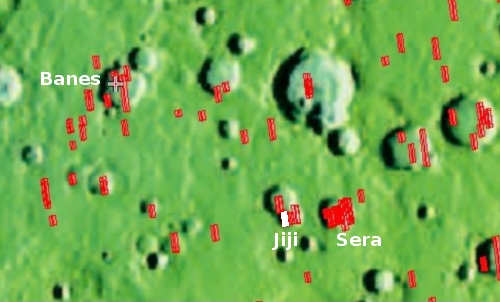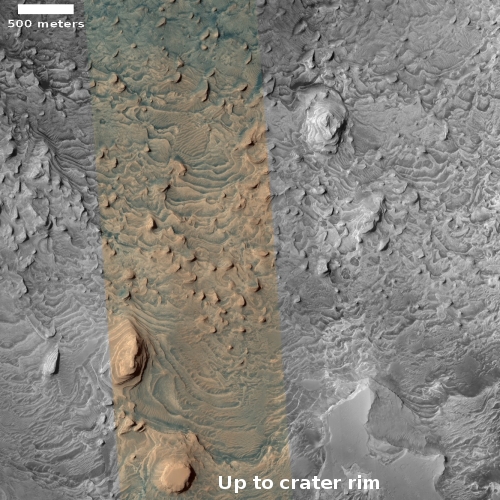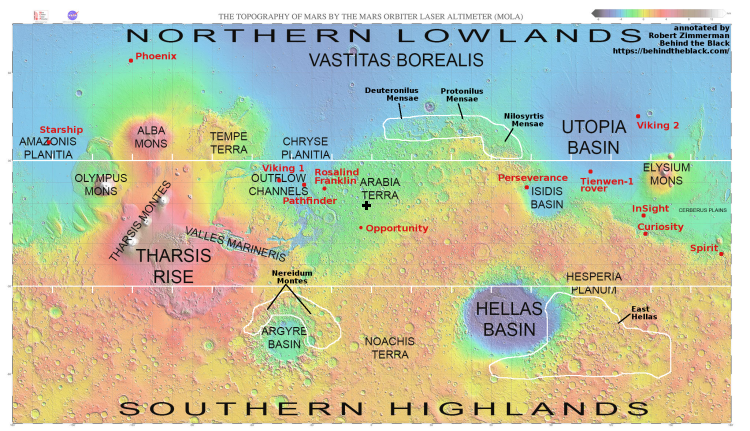First attempts to map the layered geology of Mars
Today’s cool image illustrates well the central task of much of today’s geological research on Mars, using the orbital images to try to map out the visible geological layers seen, and figure out if those layers mark over wide regions specific geological epochs, as they do on Earth.
The photo to the right, cropped and reduced to post here, was taken on May 4, 2021 by the high resolution camera on Mars Reconnaissance Orbiter (MRO), and featured on July 12th as a captioned image entitled “Layers Blanket a Crater Floor.” From the caption:
This image shows a layered rock formation within Jiji Crater that has eroded into buttes and stair-like layers.
This formation extends west and east. Similar layered rocks are within several craters in Arabia Terra and Meridiani Planum, including [nearby] Sera and Banes craters. The similarities suggest that the same process was forming deposits over a large geographic area long ago. Our image also indicates that much of the formation has eroded away relative to what has remained.
As you can see in the photo, the layers form a neat staircase of terraces descending from the south crater rim to the crater floor. They suggest that once the crater was filled with this material, which over time eroded away.
An image of similar layered buttes and mesas in Sera crater, only about 20 miles away, was featured here on Behind the Black in December 2020 The overview map below shows the relationship between Jiji, Sera, and Banes craters.

The red rectangles represent photos taken by MRO’s high resolution camera. The white box in Jiji marks this photo’s location. Banes Crater is about 80 miles to the northwest.
A 2020 paper [pdf] presented at that year’s virtual Lunar and Planetary Science Conference outlined the effort to map the layers found in Jiji and Sera craters, to see if any specific layers could be identified in both. Sadly, though a few layers seemed to match, the data was insufficient to link the geology of both craters. From the paper’s conclusion:
- 1. Stratigraphic columns in two locations are reconstructed with two methods.
- 2. Geologic modeling produced similar stratigraphic columns to cross-correlation with higher confidence in the bed thickness measurements.
- 3. We have attempted a preliminary regional correlation of strata at the bedding scale, but find no convincing correlation.
- 4. The strata could be within the same formation but from disjoint sections of the stratigraphy.
In other words, the layered strata might represent similar geology epochs, but if so the available orbital data was insufficient to prove it.
While unproven, the layers across these nearby craters are likely related, and once mapped will reveal some of Mars’ past geological history. It is for this reason scientists use MRO to take a lot of pictures of layers, as figuring this out will be one of their most important tasks in trying to unravel Mars’ past.
The global map below provides the larger context. The black cross in Arabia Terra notes the location of these craters, about 350 miles north of the landing site of the rover Opportunity. The white lines at 30 degrees latitude north and south mark out the limits of near surface ice. Today’s image is in the equatorial regions where there is no evidence of near surface ice or water. The white outlined regions in higher latitudes mark areas where there is a lot of evidence of glaciers and ice.
On Christmas Eve 1968 three Americans became the first humans to visit another world. What they did to celebrate was unexpected and profound, and will be remembered throughout all human history. Genesis: the Story of Apollo 8, Robert Zimmerman's classic history of humanity's first journey to another world, tells that story, and it is now available as both an ebook and an audiobook, both with a foreword by Valerie Anders and a new introduction by Robert Zimmerman.
The print edition can be purchased at Amazon or from any other book seller. If you want an autographed copy the price is $60 for the hardback and $45 for the paperback, plus $8 shipping for each. Go here for purchasing details. The ebook is available everywhere for $5.99 (before discount) at amazon, or direct from my ebook publisher, ebookit. If you buy it from ebookit you don't support the big tech companies and the author gets a bigger cut much sooner.
The audiobook is also available at all these vendors, and is also free with a 30-day trial membership to Audible.
"Not simply about one mission, [Genesis] is also the history of America's quest for the moon... Zimmerman has done a masterful job of tying disparate events together into a solid account of one of America's greatest human triumphs."--San Antonio Express-News
Today’s cool image illustrates well the central task of much of today’s geological research on Mars, using the orbital images to try to map out the visible geological layers seen, and figure out if those layers mark over wide regions specific geological epochs, as they do on Earth.
The photo to the right, cropped and reduced to post here, was taken on May 4, 2021 by the high resolution camera on Mars Reconnaissance Orbiter (MRO), and featured on July 12th as a captioned image entitled “Layers Blanket a Crater Floor.” From the caption:
This image shows a layered rock formation within Jiji Crater that has eroded into buttes and stair-like layers.
This formation extends west and east. Similar layered rocks are within several craters in Arabia Terra and Meridiani Planum, including [nearby] Sera and Banes craters. The similarities suggest that the same process was forming deposits over a large geographic area long ago. Our image also indicates that much of the formation has eroded away relative to what has remained.
As you can see in the photo, the layers form a neat staircase of terraces descending from the south crater rim to the crater floor. They suggest that once the crater was filled with this material, which over time eroded away.
An image of similar layered buttes and mesas in Sera crater, only about 20 miles away, was featured here on Behind the Black in December 2020 The overview map below shows the relationship between Jiji, Sera, and Banes craters.

The red rectangles represent photos taken by MRO’s high resolution camera. The white box in Jiji marks this photo’s location. Banes Crater is about 80 miles to the northwest.
A 2020 paper [pdf] presented at that year’s virtual Lunar and Planetary Science Conference outlined the effort to map the layers found in Jiji and Sera craters, to see if any specific layers could be identified in both. Sadly, though a few layers seemed to match, the data was insufficient to link the geology of both craters. From the paper’s conclusion:
- 1. Stratigraphic columns in two locations are reconstructed with two methods.
- 2. Geologic modeling produced similar stratigraphic columns to cross-correlation with higher confidence in the bed thickness measurements.
- 3. We have attempted a preliminary regional correlation of strata at the bedding scale, but find no convincing correlation.
- 4. The strata could be within the same formation but from disjoint sections of the stratigraphy.
In other words, the layered strata might represent similar geology epochs, but if so the available orbital data was insufficient to prove it.
While unproven, the layers across these nearby craters are likely related, and once mapped will reveal some of Mars’ past geological history. It is for this reason scientists use MRO to take a lot of pictures of layers, as figuring this out will be one of their most important tasks in trying to unravel Mars’ past.
The global map below provides the larger context. The black cross in Arabia Terra notes the location of these craters, about 350 miles north of the landing site of the rover Opportunity. The white lines at 30 degrees latitude north and south mark out the limits of near surface ice. Today’s image is in the equatorial regions where there is no evidence of near surface ice or water. The white outlined regions in higher latitudes mark areas where there is a lot of evidence of glaciers and ice.
On Christmas Eve 1968 three Americans became the first humans to visit another world. What they did to celebrate was unexpected and profound, and will be remembered throughout all human history. Genesis: the Story of Apollo 8, Robert Zimmerman's classic history of humanity's first journey to another world, tells that story, and it is now available as both an ebook and an audiobook, both with a foreword by Valerie Anders and a new introduction by Robert Zimmerman.
The print edition can be purchased at Amazon or from any other book seller. If you want an autographed copy the price is $60 for the hardback and $45 for the paperback, plus $8 shipping for each. Go here for purchasing details. The ebook is available everywhere for $5.99 (before discount) at amazon, or direct from my ebook publisher, ebookit. If you buy it from ebookit you don't support the big tech companies and the author gets a bigger cut much sooner.
The audiobook is also available at all these vendors, and is also free with a 30-day trial membership to Audible.
"Not simply about one mission, [Genesis] is also the history of America's quest for the moon... Zimmerman has done a masterful job of tying disparate events together into a solid account of one of America's greatest human triumphs."--San Antonio Express-News



